Ultralight aircraft engine
gauges!
In the early days of ultralight
aviation we used whatever we could find (or afford) to get ourselves into
the air. In many cases our primitive craft were powered by a Mac 101 go
cart engine, the 100 cc Yamaha go cart engine, two Chrysler West Bend
engines belted together, or modified Pioneer chainsaw engines. The
monetary investment in these engines could range from nothing, to several
hundred dollars, and we generally got what we paid for!
With little money tied up in the
engines, it didn't make any sense to spend hundreds of dollars in engine
instruments to monitor them. We new they were going to quit we just didn't
know when!
Today even the cheapest engine starts at over $2,000 and can run upwards
of $20,000. When you consider the craft they are installed in might cost
another $20,000 plus the time and effort required to built it , it makes
common sense to spend a little money to watch over our investment. Some of
these instruments are required to insure proper performance, others are
used to tune the engine, while others are used watch for engine problems
such as overheating. Lets look at some of the instruments that should be
found on most two and four stroke Rotax engines. (Remember a two stroke is
a two stroke, and a four stroke a four stroke, no matter who the
manufacturer is, thus this basic information can be used for other
engines.
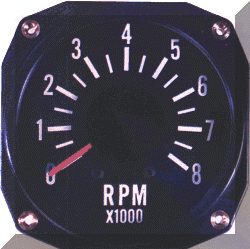
Tachometer
The tachometer plays a very important role in engine ensuring
proper engine cooling and performance. An engine allowed to over rev will
run a lean fuel and can result in engine overheating and possibly engine
failure due to seizure. If the engine is not allowed to rev up to its
proper RPM this can cause engine overheating, or engine failure due to the
engine not being able to burn the fuel they way it was designed to. A
pilot taking off on an engine that can only develop 5900 RPM can attest to
the fact that his engine will loose power and eventually quit. So what
role does the tachometer play in all this? The tachometer is used to
properly pitch the propeller, and a properly pitched prop means the engine
will, if everything else is correct, provide the best climb, cruise and
engine performance available.
To achieve this you most know what
engine RPM your engine was designed to do in straight and level flight
under full power application. Since you can't do this safely in the air,
you must do it on the ground, with the craft tied down. There is one other
problem since the craft moving through the air is provide clean air
entering the prop at whatever speed you are doing, and a plane tied down
only has the advantage of clean air into it, you must allow for this when
setting the propeller.
Example:
A 503 and or 582 Rotax twin carbed two stroke engine should rev
up to 6500 RPM in straight and level flight under full power. Experience
has shown that this can be achieved if the craft is tied to the ground and
the prop is set so that under full power the engine can only pull about
6200 to 6300 RPM. This should give you 6500 in the air. Since all Rotax
engines are supplied with a break in procedure and it is required that it
be done before the engine is put into service, the first time you will use
your tachometer is to set the pitch on your prop for the break in. An
engine that is allowed to pull 7200 RPM tied down on the ground is not
likely to make it through the whole break in procedure, without seizing
up!
Just as an engine that is set for 5500 RPM will start to loose power and
RPM after about 10 minutes.
For
more information click here.
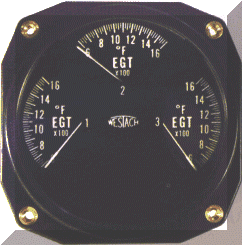
Exhaust Gas Temperature
Gauge (EGT)
The next gauge that should be on all Rotax engines is an EGT,
and you should have a separate gauge and lead for each cylinder! You can't
just stick a probe in the center of the "Y" pipe and expect to get a
proper reading. New Rotax exhaust manifolds provide a spot to install the
probes. On older systems it is necessary to measure out from the PISTON,
100 mm and then drill a hole in center of the "Y" pipe on each side.
According to the factory exhaust gasses exiting the engine are the hottest
on Rotax engines at this distance. (Picture a flame from a propane torch,
it is hottest at the end of dark blue flame.) When routing the probes do
not "COIL" them up try to run them as straight as possible without
overlapping them.
An exhaust gas temperature gauge can show you whether your engine
combustion chamber is running to hot or cold, lean or rich. It can also
indicate problems with the engine.
For example:
-if your intake manifold were to develop a crack this could
cause a lean fuel mixture, which would result in a higher EGT on that
side.
-if the needle in the throat of the carb were to wear and drop down a
notch this would show up on your EGT.
-if your gas to oil mixture was wrong it would show up quickly on the EGT.
-if something was wrong with your ignition system, a bad spark plug or
faulty ignition cap/coil/wire this would show up as a colder EGT reading,
since the fuel isn't being burned properly.
-if your prop is not set correctly it will show up in your EGT temps
-if a problem develops in one carb due too much or too little fuel this
will show up in the EGT prior to take off it is very important that the
engine be brought up to operating temperature, 1000 to 1200 degrees F you
use EGT gauges to do this.
The proper EGT reading for all two stroke Rotax engines is 1,000 to 1,200
degrees F.
For
more information click here.
For Ducati ignition click here.
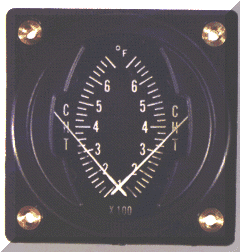
Cylinder Head Temperature
Gauges
Experience has shown that CHT's on two stroke engines are a waste of
money. By the time a gauge reacts through the head to tell you, you have a
problem your prop has stopped and you already know it.
On a liquid cooled engine the reading is effected by the water circulating
through the cylinder head, lowering the readings. They will however tell
you when you are loosing coolant, or are low on coolant since the CHT
temps are higher when the coolant is low. In most cases pilots will find
that they will smell the coolant before they notice it on the gauge.
If you are going to install a CHT you still require one for each cylinder,
don't "COIL" the leads, and it is necessary to remove the spark plug ring
when installing the CHT sending unit. Failure to remove the spark plug
ring may result in leakage due to improper sealing. It can also result in
damage to the threads of the spark plug hole.
With the spark plug sealing ring in place and the addition of the CHT
coupler threads in lower part of the cylinder head are exposed and will
carbon up. This will result in damage to the threads if a new plug is put
in place without a CHT coupler, since the spark plug can now go all the
way down into these carboned threads, usually breaking them off and
depositing them into the cylinder.
For more
information click here.
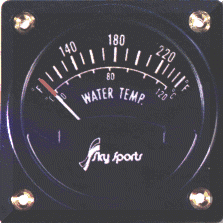
Water Temperature Gauges
On liquid cooled engines these are mandatory. Rotax liquid
cooled two stoke engines are designed to run at between 140 and 180
degrees F. With the optimum temperature coming in at around 160 degrees
F.
It is also necessary to bring the engine up to operating temperature prior
to full power application. Failure to do some can result in "COLD"
seizure. This can happen when an engine has been left at an idle for long
periods of time just prior to take off or during a long slow approach from
altitude, with full power applied suddenly for a go around.
What happens is the engine coolant has being cooled in the radiator,
(super cooled in winter) full power is applied forcing this cold mixture
up into the water jackets around the cylinders. This coolant shocks the
cylinders shrinking them at a time when the piston is under load and
expanding rapidly! The result the cylinder and piston react together to
cause a seizure.
To prevent this warm you engine up prior to take-off, a thermostat aids in
a faster warm up, and during long slow approaches, when the engine is left
idling for long periods occasionally rev the engine to move fluid through
the engine. AND if power is needed for a go around apply power SLOWLY to
allow temperatures to come up gradually.
For
more information click here.
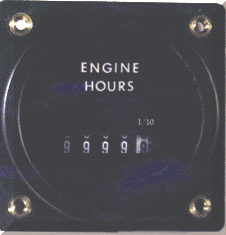
Hour meter
While some may think that this is not a necessary gauge I believe it is.
When you sit around and chat with pilots you will find that they seem to
"talk flying" more than they fly.
Thus someone who has flown for years and has hundreds of hours under his
belt will usually find that those hundreds are reduced considerably when
checked against an hour meter.
All of the new dual CDI two stroke
Rotax engines require rebuilding, which includes CRANKSHAFT REPLACEMENT
not crankshaft rebuilding at 300 hours or 5 years.
While many have been know to go on longer those that haven't usually
destroy the engine when the connecting rod comes through the side of the
block. An hour meter ensures that you have an accurate engine hour log.
For more engine instrument information click here.
|







